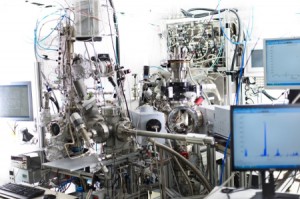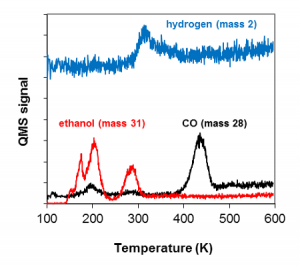 Surface reactions on metallic surfaces are important for applications as catalysis, fuel cells and capping layers for optics in extreme ultraviolet (EUV) lithography tools. For all these applications, insight in the mechanisms of adsorption and reactions of molecules on surfaces is critical for fundamental understanding, as well as for further development of new materials and processes for applications. In this publication we investigate the reactions of ethanol on the (0001) crystal face of ruthenium with the aid of temperature-programmed desorption (TPD) and reflection-absorption infrared spectroscopy (RAIRS). This research was carried out in the EUV lab research group, located at ASML Research in Veldhoven, the Netherlands. This group is an integral part of the Industrial Focus Group XUV Optics from the MESA+ Institute for Nanotechnology, University of Twente, the Netherlands. Due to the high sensitivity of TPD carried out with a quadrupole mass spectrometer with secondary electron multiplier and pulse-counting electronics, sub-monolayer coverages of molecules can be readily detected.
Surface reactions on metallic surfaces are important for applications as catalysis, fuel cells and capping layers for optics in extreme ultraviolet (EUV) lithography tools. For all these applications, insight in the mechanisms of adsorption and reactions of molecules on surfaces is critical for fundamental understanding, as well as for further development of new materials and processes for applications. In this publication we investigate the reactions of ethanol on the (0001) crystal face of ruthenium with the aid of temperature-programmed desorption (TPD) and reflection-absorption infrared spectroscopy (RAIRS). This research was carried out in the EUV lab research group, located at ASML Research in Veldhoven, the Netherlands. This group is an integral part of the Industrial Focus Group XUV Optics from the MESA+ Institute for Nanotechnology, University of Twente, the Netherlands. Due to the high sensitivity of TPD carried out with a quadrupole mass spectrometer with secondary electron multiplier and pulse-counting electronics, sub-monolayer coverages of molecules can be readily detected.
Our results show that a part of the adsorbed ethanol molecules desorbs as intact ethanol, while another fraction undergoes abstraction of the CO group and H atoms, leading to desorption of molecular hydrogen and carbon monoxide, as well as deposition of surface carbon on the ruthenium. From the desorbing reaction products, in combination with RAIRS measurements, it could be derived that this reaction proceeds via an oxametallacycle intermediate, which has also been reported for several other metal surfaces. The surface carbon arising from the decomposition reaction poisons the Ru surface for next reactions cycles, which leads to gradual deactivation of the surface. Finally, the quantitative nature of TPD allowed us to make estimates about the amount of molecules that desorb molecularly versus the fraction that undergo decomposition.

Figure 1. Set-up for studying surface reactions with TPD and RAIRS. This set-up is attached to an EUV source, such that photo-induced reactions can be studied as well

Figure 2. TPD spectrum of ethanol adsorbed on Ru(0001) below 100 K, showing the desorbing products ethanol, hydrogen and carbon monoxide
Project Summary By:
J. M. Sturm
Materials innovation institute M2i
Mekelweg 2, 2628 CD Delft
The Netherlands
Reference:
Reference:
J. M. Sturm, C. J. Lee & F. Bijkerk (2013) “Reactions of ethanol on Ru(0001)” Surface Science 612, 42-47
Visit Product Page : 3F-PIC
View Full Newsletter : Mass Spectrometers for UHV Surface Science
Make an enquiry : Send us a message

